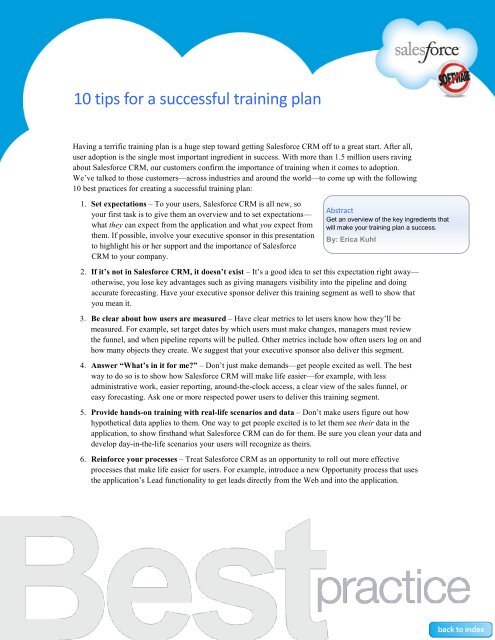Best Practices for Implementing Salesforce CRM - Cloud Experts
Best Practices for Implementing Salesforce CRM - Cloud Experts
Best Practices for Implementing Salesforce CRM - Cloud Experts
You also want an ePaper? Increase the reach of your titles
YUMPU automatically turns print PDFs into web optimized ePapers that Google loves.
10 tips <strong>for</strong> a successful training planHaving a terrific training plan is a huge step toward getting Sales<strong>for</strong>ce <strong>CRM</strong> off to a great start. After all,user adoption is the single most important ingredient in success. With more than 1.5 million users ravingabout Sales<strong>for</strong>ce <strong>CRM</strong>, our customers confirm the importance of training when it comes to adoption.We’ve talked to those customers—across industries and around the world—to come up with the following10 best practices <strong>for</strong> creating a successful training plan:1. Set expectations – To your users, Sales<strong>for</strong>ce <strong>CRM</strong> is all new, soyour first task is to give them an overview and to set expectations—what they can expect from the application and what you expect fromthem. If possible, involve your executive sponsor in this presentationto highlight his or her support and the importance of Sales<strong>for</strong>ce<strong>CRM</strong> to your company.AbstractGet an overview of the key ingredients thatwill make your training plan a success.By: Erica Kuhl2. If it’s not in Sales<strong>for</strong>ce <strong>CRM</strong>, it doesn’t exist – It’s a good idea to set this expectation right away—otherwise, you lose key advantages such as giving managers visibility into the pipeline and doingaccurate <strong>for</strong>ecasting. Have your executive sponsor deliver this training segment as well to show thatyou mean it.3. Be clear about how users are measured – Have clear metrics to let users know how they’ll bemeasured. For example, set target dates by which users must make changes, managers must reviewthe funnel, and when pipeline reports will be pulled. Other metrics include how often users log on andhow many objects they create. We suggest that your executive sponsor also deliver this segment.4. Answer “What’s in it <strong>for</strong> me?” – Don’t just make demands—get people excited as well. The bestway to do so is to show how Sales<strong>for</strong>ce <strong>CRM</strong> will make life easier—<strong>for</strong> example, with lessadministrative work, easier reporting, around-the-clock access, a clear view of the sales funnel, oreasy <strong>for</strong>ecasting. Ask one or more respected power users to deliver this training segment.5. Provide hands-on training with real-life scenarios and data – Don’t make users figure out howhypothetical data applies to them. One way to get people excited is to let them see their data in theapplication, to show firsthand what Sales<strong>for</strong>ce <strong>CRM</strong> can do <strong>for</strong> them. Be sure you clean your data anddevelop day-in-the-life scenarios your users will recognize as theirs.6. Rein<strong>for</strong>ce your processes – Treat Sales<strong>for</strong>ce <strong>CRM</strong> as an opportunity to roll out more effectiveprocesses that make life easier <strong>for</strong> users. For example, introduce a new Opportunity process that usesthe application’s Lead functionality to get leads directly from the Web and into the application.
















